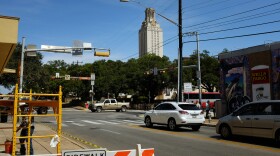Austin voters now have a clearer roadmap for a slate of bond-funded projects intended to relieve congestion and improve city infrastructure on a massive scale.
With little more than a guarantee from the Austin City Council, voters overwhelmingly approved a $720-million mobility-focused bond in 2016. Council voted Thursday to approve a construction plan for some of those projects, which will build out new bike lanes, sidewalks and road redesigns.
The plan defines how $482 million of the bond set aside for corridors will be spent along nine major Austin streets:
- Guadalupe Street
- Martin Luther King Jr. Boulevard
- North Lamar Boulevard
- Airport Boulevard
- East Riverside Drive
- Slaughter Lane
- Burnet Road
- William Cannon Drive
- South Lamar Boulevard
The construction plan outlines 11 projects – three of which are along East Riverside – that would be designed and fully funded through the $482 million.
Eight additional projects that could be partially funded along these same corridors are also laid out in the plan.
For example, one plan promises up to 6.5 miles of pavement repairs and new pedestrian crosswalk signals at nine intersections on Airport Boulevard. Money from the bond could also pay to start the design and construction for an additional 6.5 miles, but would likely require additional money to complete, according to city documents.
The proposed road changes are plucked from plans completed for these streets between 2013 and 2017. Some of these plans are nearly 300 pages long, with ideas for how these streets should look culled from community and staff input.
But fully funding the changes detailed in these plans would have cost the city an estimated $1.4 billion; to get around this, city staff prioritized changes that would "result in the biggest bang for the buck." The city hired a consultant to rank projects considering things such as a reduction in congestion, but also potential affects these road changes would have on existing neighborhoods, such as the displacement of vulnerable residents and the impact to local businesses.
Some council members on Thursday took to task the matrix used to prioritize these projects and successfully moved some funding from one portion of a road to another. Council Member Delia Garza, who represents Southeast Austin, protested this practice -- though unsuccessfully.
“It feels like a slippery slope to be moving money around," she said.
There are, of course, parts of these corridor redesigns that won't receive money from the mobility bond. The blueprint council approved Thursday lays out a wish list of 15 projects on these nine roads that will require another source of funding.





